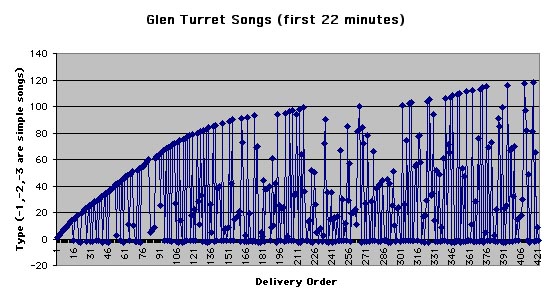|
COMPLEX SONGS
|
|
Ring Ouzels tend to start singing around an hour before first light. In the early singing, complex songs dominate the singing. They can constitute over 80% of the songs delivered in the early bouts of singing. As the day progresses simple songs are sung more often and typically become the dominant songs of full daylight singing. The complexity and diversity of the complex songs lead to the question of whether they are improvised on the spot and have no pattern or limit. Analysis of three birds' early morning singing indicates that the repertoire of complex songs is limited to a bit over one hundred types. Whether they are shared with other individuals is an open question. Complex songs last from one half second to two seconds and have two or more distinct parts. The first part, lasting from 1/4 to 1/2 second, has a noisy range of frequencies and is almost always of a higher volume than the second part. The second, quiet part could be described as twittery, but sometimes has clear, musical notes. Components of the second part are often repeated. Different deliveries of a type often have differing numbers of repetitions of one or more components of the second part of the song. Though a few of the complex songs examined have shared initial parts but have had different second parts, the vast majority of songs that share the same first part have identical second parts except for the number of repetitions of suffixes. Unlike in some thrush songs, e.g., Orange-billed Nightingale-thrush, (Catharuus aurantiirostris) and Wood Thrush, (Hylocichla mustelina), Ring Ouzel complex songs do not intersperse syllables or phrases in varying combinations and/or sequences. The sequence and combinations of phrases in song types are fixed in the songs observed and analyzed. My interpretation of the sonograms is that the two syringes are often doing different things at the same time, though I must admit that I know little about the mechanisms of bird song.
|
|
Two complex songs - bottom part shows
relative volume. High volume of last two phrases of first song is unusual.
|
|
Two songs of same
type, sung at different times with different numbers of suffixes
|
| The followng four graphs show the delivery pattern of songs during the early bouts of three birds, the first in Glen Turret, a little over an hour of singing, a second bird in the CAT glen, ten minutes, and a third bird in Norway for around twelve minutes. Complex songs are numbered as they were delivered: the first is type 1, the second is type 2, etc. The upper envelope of the graph charts the introduction of new song types; interior nodes indicate repeated songs of a type introduced earlier. In the second graph, depicting the order of song types sung in the latter half of the hour, very few new song types are introduced, indicating that the limit of the repertoire has probably been approached. Nodes under the 0 axis are records of simple song groups, of which there are three types for this bird. |
| The third graph is an early ten minutes of a bird singing in CAT glen. It has the same pattern as the first songs of the Glen Turret bird. |
| The fourth graph is an around twelve minutes of a bird singing near Åmdal, Norway at 4 AM. It has the same pattern as the first songs of the previous two birds. These three graphs allow us to conjecture from evidence that the complex song repertoire is probably between 120 and 150. |
| The fifth graph is an around twenty-five minutes of a bird singing near Les Estables , France at 5 AM. It has the same basic pattern as that of the previous two birds. The repertoire of this bird seems to be around 50, roughly one third of those in Britain and Norway. |
 |
 |
 |
 |
Complex Songs of Bird 3 at Estables, Ardeche, Auvergne, France
May 27, 2005 I recorded a bird on the ski area next to the Gite Forestiere above Les Estables, France. I recorded it in two cuts for a total of 29 minutes between 5:00 and 5:40 AM. A second bird sang in the background. The 292 songs recorded consisted of 119 simple songs of 7 types, 141 complex songs of 52 types, and 32 combo songs of 9 types. Ouzels in Spain and France sing, in addition to complex songs and groups of single type simple songs, groups of simple songs of two types. I call these heterogeneous groups combo songs. Bird 3 sang 32 combo songs, of 8 types using 14 simple types, some of which are not delivered except in combo songs. See below for access to combo songs.
The following are links to a sample of the 53 complex songs sung by bird 3 at Estables.
| FIRST FOUR | SECOND FOUR |
This chart shows the order of delivery of simple and complex songs. Combo types are not shown. The Y axis shows the type numbers of songs; numbers under 10 are for simple types, above 10 for complex types. The flattening of the graph after around 150 songs indicates that the repertoire is near 50. (Type 60 in the graph stands for complex type number 50.) This is roughly a third of the complex repertoire size in Scotland and Norway.
 |
Graph of the delivery of simple (y<10) and complex (y>10) song types |